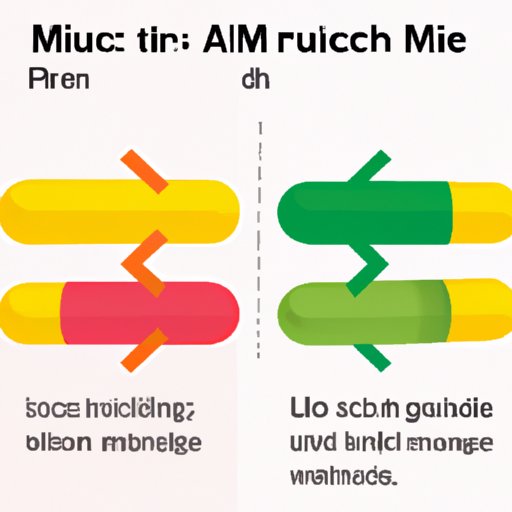
Introduction
If you’re battling cold symptoms, you may be wondering if you can take Advil and Mucinex together for relief. With so many over-the-counter cold medications on the market, it can be challenging to know which ones are safe to combine.
In this article, we’ll explore the compatibility of Advil and Mucinex and how to use them safely and effectively. Our aim is to provide you with a comprehensive guide for safe combination usage.
The Compatibility of Advil and Mucinex for Safe and Effective Pain and Cold Relief
Before we dive into this topic, it’s important to briefly go over what Advil and Mucinex are and what they do.
Advil is a brand of ibuprofen, a nonsteroidal anti-inflammatory drug (NSAID) used to alleviate pain and inflammation. Mucinex is a brand of guaifenesin, an expectorant that helps to thin and loosen mucus in the chest and throat, making it easier to cough up.
When it comes to taking Advil and Mucinex together, they are generally considered compatible and safe to use simultaneously for pain and cold relief. However, as with all medications, there are some things you need to be aware of to avoid any unwanted side effects.
Everything You Need to Know About Combining Advil and Mucinex for Maximum Symptom Relief
Knowing the right time and frequency to take each medication is crucial to maximizing symptom relief. It’s important to first check the recommended dosages on the labels of each medication before taking them together.
When it comes to using Advil and Mucinex together:
- Advil can be taken every four to six hours as needed for pain relief. However, it is recommended to take it with food or milk to avoid stomach irritation or upset.
- Mucinex is usually taken every 12 hours with a full glass of water. Drinking more than enough water helps to keep your body hydrated and can help to prevent potential side effects such as nausea or dizziness.
- It is important to follow the instructions carefully and avoid exceeding the recommended daily dosages for both medications. Taking too much of any medication can lead to unwanted side effects and potential medical complications.
Additionally, possible side effects can occur when Advil and Mucinex are taken together, such as stomach upset, dizziness, and headaches. To prevent these side effects, be sure to take these medications with a full glass of water and food.
The Benefits and Risks of Taking Advil and Mucinex Together for Cold and Pain Management
The main advantage of taking Advil and Mucinex together is that they address different symptoms of colds and flu and work together to provide relief. Advil helps to relieve pain and reduce inflammation, while Mucinex helps to loosen and thin mucus, which helps to alleviate coughs and chest congestion.
However, as with any medication, there are risks to taking Advil and Mucinex together. The most common side effects of taking ibuprofen are stomach upset, nausea, and dizziness. Taking too much ibuprofen can lead to more severe symptoms such as gastrointestinal bleeding or kidney damage. On the other hand, excessive use of guaifenesin can result in diarrhea, stomach cramping, and vomiting.
When taking Advil and Mucinex together, it’s essential to balance the risks and benefits carefully. It’s essential to follow the instructions carefully and avoid exceeding the recommended dosages for both medications. Before taking any medication, make sure to consult with your doctor, especially if you have any pre-existing medical conditions.
Breaking Down the Science of Mixing Advil and Mucinex: A Guide for Safe Medication Practices
Understanding how Advil and Mucinex work can help you use them together more safely and effectively. Advil works by blocking the enzymes that cause pain and inflammation, while Mucinex thins mucus, making it easier to cough up.
To mix Advil and Mucinex safely:
- Check the active ingredients: Before taking any medication, it’s essential to check the active ingredients. Make sure that the ingredients are compatible with each other and there are no potential side effects of taking them together.
- Know the proper dosage: As we’ve mentioned, follow the dosing instructions carefully provided by the manufacturers and stay within the recommended doses between the two drugs.
- Be cautious of potential side effects: Be aware of potential side effects of taking the medications together and check with a doctor if you are concerned.
Also, if you have a pre-existing medical condition, talk to your healthcare provider before taking any medication.

Choosing the Right Combination: A Comprehensive Look at the Interactions Between Advil and Mucinex
There are several versions of both Advil and Mucinex, and choosing the right combination can help you get maximum symptom relief.
The different forms of Advil have different dosages, so make sure you choose the appropriate one for your needs. Children and younger teens should avoid taking Advil or any pain-relieving medicine without first consulting with a healthcare professional.
When it comes to Mucinex, different versions contain different active ingredients. Some formulations contain guaifenesin alone, while others contain a combination of guaifenesin and some cough suppressants. Make sure you choose the appropriate formulation, which can help you manage symptoms more effectively.
Dispelling Myths and Exploring Facts: A Review of the Safety and Effectiveness of Advil and Mucinex Together
There are some myths and misconceptions surrounding Advil and Mucinex usage that need to be dispelled with scientific evidence. One misconception is that taking these medications together can cause more harm than good. However, if taken correctly, these two drugs can provide safe and effective relief for cold and flu symptoms.
According to a survey done by the American Pharmacists Association in 2021, over-the-counter combination products are now the most frequently used form of cold and flu medicines in the United States.
Conclusion
Combining Advil and Mucinex can be a safe and effective way to manage cold symptoms, but it’s essential to do so carefully. Be aware of the recommended dosages and potential side effects when taking these medications together and make sure to consult with your doctor if you have any pre-existing medical conditions.
Remember, the goal of combining these medications is to achieve maximum symptom relief and not to exacerbate any underlying health issues.




